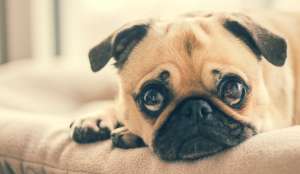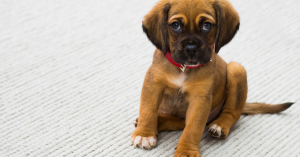


Bringing home your new puppy can be an exciting and joyous time for everyone involved. One of the very first things you will be doing with your new canine companion is building trust, beginning obedience training, and of course house training so that he can live as a happy and welcomed family member within your home. However, many people are lost when it comes to how to potty train a puppy.
Potty training is not as stressful as it may seem, and you most certainly never have to punish your puppy for a misplaced potty accident! Preventing mistakes and helping your dog to learn what you do want him to do instead of punishing unwanted behavior leads to a lifelong reliable potty habit.
Accident Prevention



When we speak of prevention, we mean that your puppy should not be given the opportunity to potty outside of his designated potty place (this could mean a puppy pad, litter box, or outdoors). Prevention includes keeping your puppy contained in a safe and properly sized crate, playpen, or quiet room whenever you cannot keep your eyes on him at all times. Doing this keeps him from being able to potty on your floor or furniture, and thus potty mistakes are reduced if not prevented completely.
However, to make sure he also never potties in his confined space it is up to you to make sure he is able to relieve himself as often as he needs. Your new puppy should be taken to his potty place and given bathroom breaks regularly including:
- Every 40 minutes to 1-hour
- About 20 minutes after eating or drinking
- Directly after all play and training sessions
- First thing when he wakes up
- & Last thing before bed
If you remove food and water from his reach within 4 hours of bedtime and he is allowed to eliminate before sleep then he should sleep throughout the entire night without needing another potty break. With consistency, this popular potty schedule will enforce a habit in him, making his needs predictable and easy to manage.
With proper training, you can stop Coprophagia before it begins and prevent other health-related concerns.
How to Potty Train a Puppy: What NOT to Do
Accidents and messes happen. If your puppy makes a potty mistake, rubbing his nose in it, yelling at him, hitting him, or making him go into his crate are all punitive consequences that can directly harm, if not completely break, the trust he has in you.
Furthermore, dogs simply do not understand this form of learning the way a human does. He will not associate his potty action with your anger, but he will associate you with the pain or punishment that you give him.
Clean up any mess with an enzymatic cleaner and consider how he was given the chance to make this mistake. Did you ignore his body language giving the signs that he needed to go, or were you not paying attention? Perhaps he was out of your sight for a short time and that is when it occurred. Find the mistake and fix it to prevent further problems.
Reward-Based Training for Puppies & Dogs



It was B.F. Skinner, the famous scientist who discovered that behavior that was rewarded with a primary reinforcer, such as food, is more likely to happen again than behavior that was nor rewarded. Likewise, he found that behavior that was punished did happen on occasion but not as often as if nothing occurred afterward. Through his proven research, we are able to correctly and easily train our new puppies that relieving themselves in their designated area is a rewarding behavior.
Spotting the Signs
If you reward your puppy for doing his business in the correct place, then praise and a reward will tell him that what he did was correct and it brought along something he desired, such as food or play. While he begins to associate his need to potty with going to his potty place, he will develop a behavior that lets you know he needs to go. This will take some observation skills on your part, as no two puppies ask to go in the same way all the time. For instance, your puppy may bark, whine, or scratch at the door when he needs to go.
Another may paw at his leash, as he associates the leash with going out. When he is taken to his place and relieves himself, he will associate this behavior with the rewards that follow. In time, just going potty is a self-reinforcing behavior all on its own for the relief he gets when he goes and the association he has been conditioned for with going in the right place.
How to Potty Train a Puppy: Final Thoughts



Be patient with your puppy during this process. Work on training at his own pace but stick to your schedule. Your consistency in his potty and meal schedule will speed up his house training process substantially. Keep in mind that young puppies are not able to hold it for long as their bodies are still developing. This is why it is so important that you are the one who takes him at the right times, so he will never become comfortable doing his business in the house. With adamant consistency, your puppy will potty in the right spot every time!
Do you have any tips or tricks when it comes to how to potty train a puppy I’d love to hear them and so would our readers! Drop a comment in the section below to start the discussion.
Natasha Moore is a professional SEO content writer and owner of Word Brokers, LLC. She enjoys traveling, hanging out with pups of all sorts, and reading the biggest books she can find. She’s also a full-time digital nomad, and you can find her writing content from the beach in Mexico, a corner coffee shop in Colombia, or lounging by the lake in Guatemala.

2 Comments
altyazili
Pretty! This was an incredibly wonderful article. Many thanks for providing these details. Darsie Orbadiah Karleen